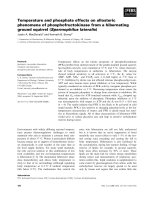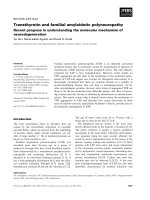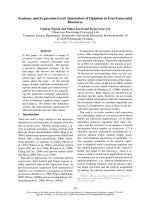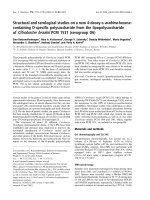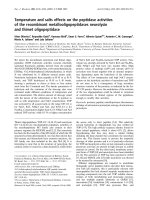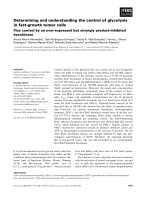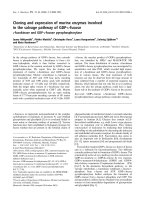báo cáo khoa học: "Single and two-stage selection on different indices in open nucleus breeding systems" pps
Bạn đang xem bản rút gọn của tài liệu. Xem và tải ngay bản đầy đủ của tài liệu tại đây (742.73 KB, 17 trang )
Single
and
two-stage
selection
on
different
indices
in
open
nucleus
breeding
systems
J.P.
MUELLER
School
of
Wool
and
Pastoral
Sciences,
The
University
of
New
South
Wales
Kensington,
N.S.W.,
Australia,
2033
Summary
When
different
information
is
available
from
the
various
parts
of
a
population
the
construction
of
correspondingly
different
selection
indices
is
required.
Selection
criteria
used
for
males
may
differ
from
those
for
females
and
in
open
nucleus
systems,
indices for
the
nucleus
may
not
apply
for
the
base.
In
order
to
test
the
effects
of
alternative
allocation
of
selection
efforts
and
to
find
the
optimum
breeding
design
in
each
case,
formulae
were
adapted
to
predict
the
rate
of
genetic
gain
in
open
nucleus
systems
with
varying
selection
criteria.
Selection
on
different
index
sets
may
occur
in
one
or
two
stages
including
progeny
testing.
Evaluations
for
a
range
of
arbitrarily
chosen
index
sets
indicates
that
the
genetic
gain
in
a
nucleus
system
is
particularly
sensitive
to
changes
in
the
relative
accuracy
of
indices
used
for
sires
and
for
base
females.
A
similar
improvement
of
selection
accuracy
of
sires
and
base
females
increases
genetic
gain
by
20-45
p.
100
and
10-20
p.
100
respectively.
The
higher
limit
is
achieved
when
selection
accuracy
in
the
opposite
sex
is
low.
In
two-stage
programs
and
progeny
testing
schemes,
results
depend
on
the
relative
accuracy
of
indices
used
in
the
two
stages.
When
sires
are
most
accurately
evaluated,
opening
the
nucleus
adds
little
to
the
gain
in
the
system,
whereas
accurate
selection
of
base
born
females
in
a
single
stage
or
after
a
first
screening
makes
the
open
nucleus
structure
very
attractive.
The
results
are
used
to
compare
alternatives
and optimise
design
in
a
simple
sheep
example.
Key
words :
Population
structure,
index
selection,
progeny
test,
open
nucleus
system.
Résumé
Sélection
en
une
et
deux
étapes
sur
différents
indices
en
systèmes
à
noyau
ouvert
L’existence
d’informations
spécifiques
à
des
sous-ensembles
d’une
même
population
implique
la
construction
d’indices
de
sélection
différents.
Les
critères
de
sélection
appliqués
aux
mâles
peuvent
différer
de
ceux
relatifs
aux
femelles ;
de
même,
dans
les
systèmes
à
noyau
ouvert,
les
indices
définis
pour
le
noyau
peuvent
être
inapplicables
à
la
population
(v
‘)
Present
address :
Instituto
Nacional
de
Tecnologia
Agropecuaria,
Casilla
de
Correo
277,
San
Carlos
de
Bariloche
8400,
Argentina.
de
base.
Aussi,
en
vue
d’étudier
l’incidence
de
différentes
politiques
de
sélection
et
d’opti-
miser
celles-ci,
des
formules
ont
été
mises
au
point
qui
expriment
le
gain
génétique
en
système
à
noyau
ouvert,
en
fonction
du
critère
de
sélection
utilisé.
Une
sélection
sur
différents
jeux
d’indices
peut
survenir
en
une
ou
deux
étapes
y
compris
celle
du
contrôle
de
descendance.
L’étude
d’une
gamme
d’indices
de
sélection
arbitrairement
choisis
montre
que
le
gain
génétique
en
système
à
noyau
est
particulièrement
sensible
à
des
variations
de
la
précision
relative
des
indices
appliqués
aux
mâles
d’une
part,
et
aux
femelles
de
la
base
d’autre
part.
Une
amélioration
équivalente
de
la
précision
de
sélection
des
mâles
et
des
femelles
conduit
à
un
accroissement
du
gain
génétique
d’environ
20
à
45
p.
100
et
10
à
20
p.
100
respectivement.
Un
plafond
est
atteint
quand
la
précision
de
sélection
dans
le
sexe
opposé
reste
à
un
niveau
faible.
Pour
les
programmes
de
sélection
en
2
étapes
basés
sur
le
contrôle
de
la
descendance,
les
résultats
dépendent
de
la
précision
relative
des
indices
appliquées
à
chacune
des
étapes.
Si
les
pères
sont
connus
précisément,
l’ouverture
du
noyau
n’entraîne
qu’un
faible
gain
génétique ;
au
contraire,
l’application
d’une
sélection
précise
des
femelles,
nées
dans
la
base,
qu’elle
soit
appliquée
en
une
seule
étape
ou
après
un
tri
initial,
rend
la
structure
en
noyau
ouvert
très
attractive.
Ces
résultats
sont
appliqués
à
la
comparaison
et
à
l’optimi-
sation
de
programmes
de
sélection
de
l’espèce
ovine.
Mots
clés :
Structure
de
population,
sélection
sur
indice,
contrôle de
descendance,
système
à
noyau
ouvert.
I.
Introduction
Once
the
breeding
objective
has
been
defined,
a
breeder
has
to
choose
suitable
selection
criteria
and
design
the
breeding
program.
Maximum
response
to
selection
is
obtained
if all
available
information
is
used
in
a
selection
index.
Different
indices
must
often
be
constructed
because
the
information
available
may
vary
among
different
parts
of
a
structured
population.
This
is
of
particular
interest
in
the
evaluation
of
hierarchical
systems
with
upward
gene
migration
(open
nucleus
systems)
since,
in
these,
selection
in
the
lower
levels
contributes
to
genetic
gain
of
the
whole
system.
JAMES
(1977)
developed
formulae
to
predict
genetic
gains
in
open
nucleus
sys-
tems
and
evaluated
such
systems
assuming
the
same
selection
criterion
was
used
in
both
layers
and
sexes.
H
OPKINS
(1978)
showed
that
adopting
strategies
which
concentrate
selection
efficiency
in
the
nucleus
may
increase
the
rate
of
genetic
response
if
the
system
is
designed
appropriately.
Thus,
in
terms
of
index
selection
we
may
have
different
test
accuracies
in
the
nucleus
and
base :
such
situations
have
also
been
discussed
in
the
context
of
British
cattle
group
breeding
schemes
by
Guv
&
S
TEAN
E
(1980).
Another
possibility
is
that
selection
criteria
could
vary
between
sexes
in
the
nucleus,
and
between
nucleus
and
base
females.
Indeed,
a
further
point
worth
consi-
dering
is
two-stage
selection
in
base
females.
In
open
nucleus
systems
large
numbers
of
base
females
must
be
measured,
of
which
a
very
small
proportion
will
be
used
as
nucleus
replacements.
In
the
large
sheep
flocks
of
the
Southern
Hemisphere
this
is
at
once
the
key
advantage
and
the
major
problem
of
an
open
nucleus
system,
since
the
cost
of
measurement
prohibits
the
collection
of
detailed
information
on
all
base
females.
If
preliminary
selection
could
be
made
on
measurements
cheap
to
obtain,
followed
by
a
second
selection
on
more
expensive
criteria
obtained
for
only
a
small
fraction
of
base
females,
the
extra
genetic
gain
might
compensate
for the
additional
costs.
Similarly,
sires
could
be
selected
in
stages,
since
it
may
be
impracticable
to
retain
all
of
them
until
full
information
is
collected.
Two-stage
selection
has
not
yet
been
evaluated
in
the
context
of
open
nucleus
systems,
though
it
seems
to
be
a
promising
alternative
to
take
into
account.
A
special
case
of
two-stage
selection
of
sires
arises
when
the
second
stage
includes
progeny
test
results.
We
may
generalise
evaluations
of
open
nucleus
systems
for
single
and
two-stage
selection
by
first
rewriting
the
basic
equation
in
a
form
helpful
for
consideration
of
selection
using
different
indices.
Predicted
response
to
selection
in
nucleus
systems
with
more
than
one
index
can
then
be
used
to
define
the
optimum
breeding
design.
The
sensitivity
of
genetic
gain
in
such
systems
to
changes
in
the
accuracy
of
selection
of
different
sections
of
the
population
may
indicate
a
rational
distribution
of
effort
in
collecting
data
for
the
construction
of
different
indices.
The
aim
of
this
study
is
to
provide
explicit
methods
for
evaluating
selection
in
open
nucleus
systems
with
varying
selection
criteria,
rather
than
exploring
particular
situations.
Examples
are
given
to
illustrate
application
of
the
methods,
not
for
their
intrinsic
interest.
The
complexity
of
such
systems
requires
that
a
large
number
of
symbols
are
used
to
describe
them.
These
symbols
are
defined
in
the
text
and
summa-
rised
in
an
Appendix.
I1.
Methods
A.
Selection
based
on
a
single
index
Suppose
the
aim
is
to
improve
aggregate
genotype
G
by
selection
on
an
index
I.
In
an
open
nucleus
system
G
will
be
the
same
for
base
and
nucleus.
It
is
well
known
that
the
best
index
is
given
by
the
multiple
regression
of
G
on
the
traits
in
the
index,
and
that
the
genetic
superiority
of
a
selected
group
is
s(q)r
Gl
oG
where
s(q)
is
the
standardised
selection
differential
achieved
by
selecting
the
best
fraction
q
of
a
normal
distribution,
rm
is
the
correlation
of
index
and
breeding
objective
and
an
is
the
standard
deviation
of
G
values.
Correlations
are
unaffected
by
scale
changes
so
that
choosing
the
regression
of
G
on
I
as
unity
the
genetic
gain
in
breeding
value
is
s(q)a
j
where
a¡
is
the
standard
deviation
of
index
values.
In
what
follows
response
to
selection
is
calculated
in
the
latter
form,
one
unit
change
in
the
index
corresponding
to
a
unit
change
in
breeding
value.
In
practice
other
scales
may
be
used,
but
n;
must
then
be
interpreted
as
R
GI
(
FG
.
JAMES
(1977)
gave
a
general
expression
for
the
steady
state
genetic
gain
per
generation
in
an
open
nucleus
system
in
which
all
sires
are
selected
from
nucleus-
born
males,
a
fraction
x
of
nucleus
dams
are
born
in
the
base,
and
a
fraction
y
of
base
dams
are
born
in
the
nucleus.
The
total
proportions
of
males
and
females
selected
are
denoted
a
and
b
respectively,
and
generation
length
is
assumed
equal
in
nucleus
and
base.
Standardised
selection
differentials
for
males
used
in
the
nucleus
(iMN
)
and
the
base
(i!IB)
are :
where
p
is
the
proportion
of
the
population
in
the
nucleus.
The
remaining
selection
differentials
are
for
females.
For
example,
i
llFN
is
the
differential
for
base-born
females
used
in
the
nucleus,
and
so on.
Appropiate
selection
differentials
can
be
obtained
by
noting
that
the
proportions
to
be
selected
in
each
case
are :
Writing
the
total
proportions
selected
in
the
nucleus
and
in
the
base
as
QNFT
and
q
lrt
,
then :
B.
Different
indices
in
the
same
,system
In
this
section
we
consider
the
case
where
base
females
are
selected
on
index
I
ll’
nucleus
females
on
index
I!
and
males
are
selected
on
index
IM.
Multiplying
the
selection
differentials
in
equation
(1)
by
the
standard
deviations
of
the
corresponding
indices
(6!,
Gx
and
O’!!
respectively)
and
collecting
terms
we
find :
with
weights :
where
g
is
2
(1
+
y
+
x).
It
is
worth
noting
that
in
a
closed
nucleus
system
x
=
0
and
equation
(5)
reduces
to
(i
nzvahi
+
iNt’Na
N)/
2.
C.
Two-stage
selection
of
base
females
Suppose
selection
in
the
base
accurs
in
stages.
In
the
first
stage
a
propor-
tion
ql
is
selected
by
truncating
the
standardised
distribution
of
index
values
1,,,
at
point
t.
The
change
in
breeding
value
after
this
first
stage
is
s
(q
l
) (Ti
ll’
As
will
be
seen
later
the
fraction
selected
in
the
first
stage
is
normally
less
than
the
total
proportion
of
females
required
as
replacements
(q!!,2).
Hence
the
next
best
proportion
qa
pr
-
q,
is
used
as
replacement
in
the
base.
The
remainder
1
-
q
m’T
is
culled.
Among
those
individuals
accepted
for
the
second
stage
a
fraction
q!
is
selected
on
the
more
accurate
index
1
112’
It
is
assumed
that
information
from
the
first
stage
is
used
in
the
second.
Since
a
fixed
proportion
of
base
females
is
required
for
the
nucleus
(qm’
)B’),
the
proportions
q,
and
q2
are
not
independant
(q
l
q.,
=
QBFN
)’
A
good
approximation
of
the
gain
from
the
second
stage
selection,
due
to
CocaRnrr
(1951 ),
assumes
I
H2
and
G
remain
jointly
normally
distributed
after
the
first
selection.
Writing
il
=
s
(q
l)
and
i2
=
s
(q
z)
the
genetic
differential
of
change
in
mean
breeding
value
in
the
fraction
of base
females
for
the
nucleus
is :
where
r
is
the
correlation
between
indices
used
in
the
two
stages.
Since
1m
and
In!
are
constructed
with
the
same
breeding
objective,
r
=
O’BJ
/
0’
112’
The
factor
1
-i
2c
is
the
proportion
of
the
variance
in
11
12
left
in
the
group
saved
for
further
measure-
ments,
thus
c
=
il
(i
i
-
t).
Making
use
of
tables
of
the
bivariate
normal
distribution
it
can
be
shown
that
the
approximation
holds
well
unless
r
is
close
to
unity
in
which
case
the
second
stage
would
become
worthless.
To
find
the
genetic
differential
for
base
dam
replacements,
we
recall
that
all
surplus
animals
from
the
second
stage
selection
are
used
in
the
base :
The
genetic
gain
in
a
nucleus
system
with
two-stage
selection
of
base
females
can
be
calculated
by
replacing
i
¡wN
a
1;
and
iip
it
(Jg
in
equation
(5)
with
D
m’N
and
D
ara
from
above
such
that :
D.
Two-stage
selection
of
sires
Similarly
to
the
previous
case,
consider
sire
selection
in
two
stages.
First
a
proportion
q1
(now
we
use
q1
and
q2
for
the
selection
of
males)
is
selected
on
index
I
ml
.
Among
these
a
proportion
q,
is
selected
on
the
second
index
I!I2’
The
restriction
is
qiqz
=
a,
the
final
proportion
required
for
the
nucleus.
The
genetic
selection
differential
of
males
for
the
nucleus
is :
The
term
in
the
square
root
has
its
equivalent
in
equation
(6).
If
q,
is
less
than
the
total
proportion
of
males
required
(a/p)
we
find
the
genetic
selection
differential
of
males
for
the
base
as :
Suppose
q1
?’: alp
which
might
be
taken
when,
for
instance,
artificial
insemination
is
used
and,
therefore,
only
very
few
sires
are
needed.
In
this
case :
We
may
write
the
equation
for
the
steady
state
genetic
gain
with
two-stage
selection
of
sires
in
the
convenient
form :
The
weights
w
Ml
and
WM2
are
derived
by
simply
substituting
D!In
and
the
proper
D
MB
for
i
MN
am
and
i
mb
om
in
equation
(5).
E.
Progeny
testing
We
regard
progeny
testing
as
implying
a
nucleus
system
in
that
the
female
popu-
lation
is
divided
in
two
groups,
the
nucleus
in
which
all
prospective
sires
are
born
and
the
base
in
which
a
proportion
q1
selected
on
index
I
Dit
, of
these
young
sires
is
tested.
In
a
second
stage,
a
fraction
q2
is
chosen
on
the
combined
information
of
individual
and
progeny
performance
(index
IM.2)
and
mated
in
the
nucleus.
The
traits
need
not
be
the
same
and
may
be
sex-limited.
For
a
given
fertility
level
f
in
the
system
and
mating
ratios in
the
base
(M
B)
and
in
the
nucleus
(M
N)
expressed
as
sires/dams,
we
have
from
M
UELLER
&
JAMES
(1983)
the
proportions :
It
is
assumed
that
sires
are
used
an
equal
number
of times
in
nucleus
and
base.
The
genetic
differential
for
young
sires
is :
and
for
sires
accepted
after
the
second
stage
it
is :
The
genetic
gain
in
the
steady
state
situation
of
the
system
is
described
by
equation
(7)
with
w
mi
=
ii
/2
and
W
M2
=
i2
(1
+
y
)/
g.
F.
Evaluation
of
formulae
The
total
proportion
of
males
and
females
required
as
replacements
(a
and
b)
are
usually
characteristic
of
a
particular
population
and
to
a
large
extent
uncontrollable
except
for the
use
of
the
use
of
artificral
insemination
and
changes
in
age
structure.
The
breeder
can,
however,
manipulate
the
structure
of
the
breeding
population
by
choosing
the
size
of
the
nucleus
(p)
and
by
deciding
on
the
proportion
of
individuals
transferred
between
base
and
nucleus
(x
and
y).
Since
we
expect
selection
in
the
nucleus
to
be
at
least
as
accurate
as
in
the
base
the
optimum
nucleus
size
is
small
(JAMES,
1977)
and
y
is
then
necessarily
small.
Thus
with
little
or
no
loss
of
efficiency
we
assume
that
all
surplus
females
from
the
nucleus
are
used
in
the
base
and
restrict
our
attention
to
the
more
relevant
design
parameters
p
and
x.
In
order
to
quantify
the
response
to
selection
for
several
combinations
of
indices
we
use
equations
(5),
(6)
and
(7)
for
given
a
and
b
over
a
range
of
x
and
p.
In
the
case
of
progeny
testing,
annual
response
rate
is
calculated
in
a
population
which
requires
70
p.
100
of
females
for
replacements
(b
=
0.7),
with
fertility
level
at
80
p.
100
(f
=
0.8),
mating
ratio
in
the
nucleus
of
0.4
p.
100
(M
N
=
0.004),
and
mating
ratio
in
the
base
of
2
p.
100
(M
$
=
0.02).
The
test
is
based
on
f/M
B
=
40
offspring
of
both
sexes
per
young
sire.
Age
structure
of
females
is
the
same
in
nucleus
and
base.
Young
sires
are
used
once
in
the
base
and
those
selected
on
the
progeny
test
are
used
once
in
the
nucleus.
Age
at
first
offspring
is
2
years
in
both
sexes.
It
is
not
implied
that
age
structures
and
mating
ratios
considered
in
the
evaluations
are
always
optimal.
The
situation
described
could
apply
to
a
sheep
population
in
which
the
base
is
run
under
extensive
conditions
and
the
nucleus
having
artificial
insemi-
nation
facilities.
For
cases
other
than
progeny
testing
results
are
on
a
per
generation
basis.
The
implications
of
this
assumption
will
be
discussed
later.
III.
Results
A.
Design
of
nucleus
systems
with
single
stage
selection
A
particular
set
of
indices
is
named
by
a
3
digit
number
representing
the
standard
deviations
(or
accuracies)
of
indices
applied
to
select
males,
females
in
the
nucleus
and
females
in
the
base.
Index
set
333
serves
as
reference
and,
for
example,
index
set
231
is
a
case
where
aM
=
2,
aN -
3,
and
an =
1.
Before
analysing
particular
index
sets,
we
might
see
how
the
three
weights
WM
,
wN
and
wB
in
equation
(5)
change
with
increasing
proportion
of
base
born
females
in
the
nucleus
(fig.
1 ).
The
weight
for
males
is
large,
especially
when
intense
use
of
them
is
possible.
Thus
the
open
nucleus
structure
would
become
unfavourable
when
artificial
insemination
is
extensively
used
and
the
ratio
CM
/
UB
is
large.
The
optimum
size
of
the
nucleus
for
several
index
sets
is
shown
in
figure
2.
The
population
considered
with
replacement
proportions
a
=
0.05
and
b
=
0.7
is
typical
of
many
sheep
and
cattle
populations.
With
am
>
an
as
in
321
a
large
nucleus
would
be
suggested
whereas
the
opposite
is
appropriate
with
133.
A
comparison
of
maximum
response
rates
in
the
figures
shows
the
relative
effects
of
the
application
of
different
indices.
It
is
clear that
optimisation
of
nucleus
size
is
of
litle
effect
compared
to
changes
in
the
index
sets.
The
determination
of
the
number
of
females
which
should
be
transferred
to
the
nucleus
is
of
greater
relevance
(fig.
3).
With
large
aM
and
small
an,
x
should
be
small.
The
open
nucleus
structure
with
large
upward
transfers
becomes
particularly
efficient
with
index
sets
like
233
and
133.
The
control
set
(333)
yields
optima
as
in
figures
2
and
3
of
JAMES
(1977).
B.
Design
of
nucleus
systems
with
two-stage
selection
on
individual
performance
For
both,
the
two-stage
selection
of
base
females
and
the
two-stage
selection
of
sires,
we
need
first
to
consider
the
allocation
of
selection
intensity
to
each
stage,
that
is,
we
need
to
find
values of
q1
and
q2
so
as
to
achieve
near
maximum
gains.
Maximum
efficiency
would,
of
course,
be
to
select
the
whole
population
on
the
full
index
(1
2)
taking
q, =
1.
However,
we
want
to
measure
only
a
small
proportion
on
L,
and
still
achieve
a
high
fr
4
ction,
say
80
or
95
p.
100
of
the
possible
gain
in
D
BFN
-
Cochran
suggested
that
selecting
equal
proportions
in
a
multi-stage
program
is
approximately
optimum.
Numerical
evaluation
shows
that
for
a
range
of
final
pro-
portions
required
(q
lq2)
a
nearly
constant
efficiency
is
achieved
in
this
way,
but
the
magnitude
of
the
efficiency
depends
on
the
correlation
r
between
indices
used
(fig.
4).
For
values
of
r
in
he
range
1/3
to
2/3
selecting
equal
proportions
(q,
=
q2)
achieves
about
80
p.
100
of
the
possible
gain.
This
simple
criterion
will
be
used
in
the
examples
of
two-stage
selection
on
individual
performance.
Results
for
two-stage
selection
of
base
females
are
shown
in
figure
5
and
results
ot
two-stage
selection
of
males
in
table
1.
The
standard
deviations
of
indices
used
for
the
first
and
second
stage
appear
in
brackets
at
the
beginning
of
a
set
(6
ns1
6
M2
)
or
at
the
end
(O’
BlO’B2
)’
Results
on
optimum
design
are
as
expected.
As
selection
accuracy
increases
with
the
second
stage
the
design
parameter
shift
accordingly
towards
larger
nucleus
and
smaller
base
contribution
when
the
second
index
is
applied
to
males
and
vice
versa
when
base
born
females
are
selected
in
two
stages.
Design
with
progeny
testing
In
this
case
the
proportion
selected
in
the
first
stage
(q
i)
is
a
function
of
the
nucleus
size
for
a
given
mating
ratio
in
the
base.
The
number
of
progeny
on
which
the
test
is
based
is
independent
of
p.
Therefore
the
nucleus
should
be
very
small
to
allow
a
high
selection
intensity
on
1M2
when
this
index
is
relatively
accurate.
Popu-
lation
size
will
set
a
minimum
on
p
compatible
with
inbreeding
considerations,
but
also
pedigree
recording
may
increase
beyond
possibilities
as
the
base
becomes
larger.
Consequently
a
restricted
range
of
p
needs
to
be
taken
in
the
evaluations.
Table
2
shows
the
efficiency
of
progeny
testing
(as
the
ratio
of
AG
at
optimum
p
and
x
for
progeny
test
and
individual
selection)
when
at
least
10
p.
100
of
the
population
is
mated
to
tested
sires
(p
=
0.1).
Apart
from
the
obvious
effect
of
increasing
age
of
nucleus
sires,
it
is
also
clear
that
the
smaller
the
ratio
a
mi aM2
the
more
efficient
is
the
progeny
test.
For
index
sets
with
am,
=
1 and
for
6M1
a
M2
=
(24),
optimum
nucleus
size
is
the
minimum
considered
(p
= 0.1),
whereas
for
(23)
p
=
0.2
and
for
(34)
p
should
be
around
0.3.
Optimum
upward
transfers
(x)
are
given
in
table
3,
they
go
from
0.5
to
0.0
depending
on
how
much
more
accurate
the
progeny
test
is.
IV.
Discussion
The
equations
used
to
predict
response
to
selection
are
based
on
the
usual
assumptions
of
additive
inheritance,
multinormal
distributions
and
constant
variances
and
covariances.
The
assumption
of
equal
generation
length
in
base
and
nucleus
deserves
some
comments
in
the
light
of
the
findings
by
Horxirrs
(1978)
that
addi-
tional
response
can
be
achieved
from
optimisation
of
the
age
structure
in
a
nucleus
system.
There
is
no
particular
methodological
difficulty
in
evaluations
for
overlapping
generations.
The
response
formulae
would
need
to
be
divided
by
the
weighted
(with
transfer
rates)
average
(over
sexes)
generation
length
in
nucleus
and
base.
It
requires
trial
and
error
procedures
to
locate
the
optimum
combination
of
nucleus
size,
transfer
rates
and
number
of
age
groups
in
the
different
parts
of
the
system.
Horxirrs
(1978)
determined
optimum
age
structures
for
several
selection
strategies,
including
selection
at
one
or
all
ages
and
sequential
culling.
The
results
indicated
that
in
general
fewer
age
groups
would
be
recommended
in
the
nucleus
although
sensitivity
of
genetic
gains
to
changes
in
age
structure
becomes
negligible
the
more
efficient
selection
becomes
in
the
nucleus.
In
relation
to
the
present
work
such
more
efficient
selection
strategies
have
effectively
the
same
consequences
as
the
use
of
more
accurate
indices.
Therefore,
following
Hopkins’
results,
only
when
selection
accuracy
is
fairly
even
in
the
system
would
we
be
concerned
with
optimising
age
structures.
If
this
is
the
case
we
would
predict
slightly
higher
gains
and
smaller
transfers
and
nucleus
sizes
than
those
calculated
assuming
equal
generation
length
in
both
layers.
While
H
OPKINS
(1978)
emphasised
optimisation
of
age
structures
we
were
prima-
rily
concerned
with
the
effects
of
alternative
allocation
of
selection
efforts
in
the
different
parts
of
an
open
nucleus
scheme.
The
study
shows
that
useful
preliminary
information
for
the
design
of
complex
breeding
systems
can
be
inferred
from
inspec-
tion
of
the
weighted
selection
differentials
(w’s)
over
the
relevant
parameters
(e.g.,
x
and
p)
and
from
the
relative
size
of
accuracies
of
the
selection
indices
proposed
for
the
different
parts
of
the
system.
For
instance,
if
selection
accuracy
of
males
(a
lii
)
can
be
improved
by
one
unit
(from
1
to
2
or
2
to
3)
an
increase
in
the
genetic
gain
of
roughly
25
to
45
p.
100
could
be
achieved
depending
upon
whether
selection
of
base
females
is
very
accurate
(a
$
=
3)
or
not
(a
B
=
1).
Similarly
one
unit
improvement
in
aB
can
raise
gain
by
up
to
20
p.
100
depending
on
selection
accuracy
of
sires.
If
the
increase
in
selection
accuracy
in
the
base
arises
from
a
second
stage
selection
about
10
p.
100
extra
gain
can
be
predicted.
Again
for
two-stage
selection
of
sires,
one
unit
improvement
over
am,
yields
20
to
40
p.
100
higher
gains.
In
progeny
testing
schemes
these
extra
gains
are
diluted
by
the
larger
generation
intervals.
Application
of
the
methods
described
is
straight-forward.
As
an
example
consider
a
nucleus
system
in
a
given
sheep
population
(a
=
0.05
and
b
=
0.7).
Take
the
selection
objective
function
and
variance-covariance
matrices
as
in
PorrzoNi
(1979),
but
allowing
for
the
cost
of
producing
a
lamb
by
halving
its
price.
The
standard
deviation
of
breeding
values
aG
equals
6.2,
so
that
those
readers
who
prefer
inter-
pretations
in
r
GI
would
need
to
divide
all
index
sets
by
6.2.
Select
nucleus
females
on
clean
fleece
weight,
16-month
body
weight
and
wrinkle
score ;
select
sires
on
the
former
two
traits
alone ;
we
find
for
unscaled
indices
<1y
=
2.4
and
<1N
=
3.2
from
standard
selection
index
theory.
Now
suppose
base
females
are
selected
on
greasy
fleece
weight
(a
B
=
1.5).
Using
equation
(5)
or
interpolating
in
figures
2
and
3
we
find
the
optimum
proportion
of
the
population
in
the
nucleus
(p)
as
about
25
p.
100
and
the
proportion
of
nucleus
dam
replacements
chosen
among
base
dam
progeny
(x)
at
around
18
p.
100.
Introducing
a
second
stage
selection
in
the
base
such
that
IB.2
=
IN,
we
locate
optimum
q1
=
0.19,
p
=
0.13
and
x
= 0.36
in
figures
2,
4
and
5
or
using
equations
(6),
and
recalling
that
qlqz
=
q
nFN
= bxp
/
(1 -p).
Fortunately,
optima
are
not
sharp
and
with
little
loss
of
efficiency,
these
parameters
can
be
chosen
at
operationally
convenient
levels
near
these
results.
The
extra
gain
in
the
system
is
about
9
p.
100,
which
would
need
to
be
balanced
against
the
costs
of
additional
measurements
on
(1- p) q
l
=
17
p.
100
of the
population.
Incorporation
of
cost
functions
in
the
evaluations
may
sometimes
be
helpful,
but
it
is
unlikely
that
generally
useful
results
could
be
obtained
since
costs
and
returns
would
be
specific
to
any
particular
nucleus
system.
This
is
particularly
relevant
to
two-stage
selection
where,
depending
on
circumstances,
it
may
not
be
desirable
to
take
q,
=
q2’
Breeding
systems
including
progeny
testing
are
usually
expensive
and
substantial
rewards
in
genetic
gain
must
be
predicted
to
make
them
feasible.
Thus,
a
thorough
analysis
of
alternative
designs
and
optimisation
would
be
required.
In
many
cases
the
range
of
alternative
designs
can
be
narrowed
by
consideration
of
the
general
pattern
of
results
in
this
study.
For
illustration
consider
again
the
sheep
example.
Since
Porrzorn’s
(1979)
breeding
objective
places
a
high
weight
on
a
reproductive
trait
(number
of
lambs
weaned),
it
might
be
of
interest
to
include
a
trait
highly
correlated
with
fertility
in
the
index
for
rams.
Ovulation
rate
of
daughters
is
an
obvious
possibility.
Suppose
rams
for
the
base
and
all
ewe
hoggets
are
selected
on
clean
fleece
weight
(aN
=
<1B =
a
nfl
=
2.0)
and
rams
for
the
nucleus
are
selected
in
a
second
stage
on
clean
fleece
weight
and
the
average
ovulation
rate,
measured
before
first
joining,
of
20
daughters
(O
M2
=
3.3).
The
age
of
rams
in
,the
nucleus
is
4
years.
From
table
2
we
would
expect
an
improvement
of
about
8
p.
100
over
single
stage
selection.
However,
with
additional
information
in
1m,
such
as
16-month
body
weight
and
wrinkle
score,
a
Ml
= 3.2
and
a
n2
= 4.1,
and
single
stage
selection
becomes
more
efficient
(about
7
p.
100).
Thus
even
with
the
very
optimistic
genetic
correlation
of
ovulation
rate
and
number
of
lambs
weaned
of
0.8
assumed
(other
genetic
and
phenotypic
correlations
involving
ovulation
rate
taken
as
zero),
there
is
no
point
in
progeny
testing
when
there
is
scope
to
improve
first
stage
selection
accuracy.
The
conclusions
drawn
from
this
example
are,
of
course,
restricted
to
populations
which
satisfy
the
particular
genetic
parameters
assumed.
Received
December
13,
1982.
Accepted
August
S,
1983.
Acknowledgements
I
wish
to
thank
D’
J.W.
James
for
many
helpful
suggestions.
Support
from
the
Instituto
Nacional
de
Tecnologia
Agropecuaria,
LN.T.A.
(Argentina)
is
greatfully
acknowledged.
’
References
CocxRnrr
W.G.,
1951.
Improvement
by
means
of
selection.
Proceedings
of
the
Second
Berkeley
Symposium
on
Mathematical
Statistics
and
Probability.
Neyman
J.
(ed.),
449-470,
University
of
California
Press,
Berkeley.
G
UY
D.R.,
S’
rEnNS
D.E.,
1980.
The
optimisation
of
group
breeding
schemes.
31st
Annual
Meeting,
European
Association
for
Animal
Production,
Munich,
Germany,
Septem-
ber
1-4,
1980,
H
OPKINS
LR.,
1978.
Some
optimum
age
structures
and
selection
methods
in
open
nucleus
breeding
schemes
with
overlapping
generations.
Anim.
Prod.,
26,
267-276.
JAMES
J.W.,
1977.
Open
nucleus
breeding
systems. Anim.
Prod.,
24,
287-305.
M
UELLER
J.P.,
JAMES
J.W.,
1984.
Design
and
evaluation
of
progeny
testing
in
open
nucleus
breeding
systems.
Anim.
Prod.,
38
(in
press).
PorrzoNt
R.W.,
1979.
Objectives
and
selection
criteria
for
Australian
Merino
sheep.
Pro-
ceedings
of
the
Australian
Association
of
Animal
Breeding
and
Genetics,
1,
320-336.
Appendix
Table
of
symbols
a
proportion
of
males
required
as
replacements
b
proportion
of
females
required
as
replacements
x
proportion
of
nucleus
female
replacements
born
in
the
base
(upward
female
transfer
rate)
y
proportion
of
base
female
replacements
born
in
the
nucleus
(downward
female
transfer
rate)
p
nucleus
size
as
a
fraction
of
total
population
g
= 2 (1 + y + x) or
two
times
the
total
transfers
f
fertility
level,
number
of
successfully
reared
progeny
per
female
joined
q
refers
to
proportions
s (q)
selection
differential
when
an
upper
tail
area
q
is
selected
from
a
normal
distribution
i
standardised
selection
differential,
used
to
shorten
s (q)
Subscripts
for
q
and
i :
1
and
2 :
refer
to
first
and
second
stage
selection
MN
and
MB :
males
for
the
nucleus
and
males
for
the
base
NFN,
NFB,
BFN
and
BFB :
nucleus
born
females
used
in
the
nucleus,
nucleus
females
used
in
the
base,
base
females
used
in
the
nucleus
and
base
females
used
in
the
base
I
selection
index
G
agregate
breeding
value
0
’1
standard
deviation
or
accuracy
of
index
I
aG
standard
deviation
of
breeding
values
r
GI
correlation
of
breeding
values
and
index
r
correlation
of
indices
used
in
first
and
second
stage
equal
Cr
Il/(
TI2
MN,
M
ll
mating
ratios
(sires/dams)
in
nucleus
and
base
Index
sets :
sets
of
three
digits
say
accuracies
of
indices
used
for
males,
nucleus
females
and
base
females ;
in
general :
O
’)
IO’:I
1O’B
two
digits
in
brackets
indicate
accuracies
of
indices
used
in
the
first
and
second
stage ;
in
general
(0
’M1
O
’M2
)O’:I1
aL
or
a!i6x
(O
’mO
’
B2
)
4G
rate
of
genetic
gain
in
units
of
breeding
value.

